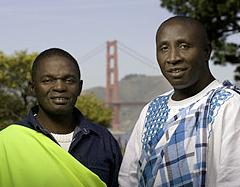2009 Goldman Environmental Prize Winners Beat 'Insurmountable' Odds
SAN FRANCISCO, California, April 20, 2009 (ENS) — The 2009 Goldman Environmental Prize winners are grassroots environmental leaders from around the world who have fought mining companies, logging development, mounting piles of solid waste, toxic dumping and government indifference to tribal rights.
 |
Richard Goldman, front left, with the 2009 Goldman Prize winners, except Marc Ona. |
Now in its 20th year, the Goldman Environmental Prize is awarded annually to environmentalists from each of the world's six inhabited continental regions. It is the largest award of its kind with an individual cash prize of $150,000 for the prize winner from each region. Multiple winners share the regional prize.
"This group of Goldman Prize recipients are as impressive as ever, taking on seemingly insurmountable struggles and achieving success," said Goldman Prize founder Richard Goldman. "In this, our 20th year, we are pleased to bring attention to their courageous work."
The winners will receive their awards at an invitation-only ceremony this afternoon at the San Francisco Opera House. They will also be honored at a smaller ceremony on Earth Day, Wednesday, April 22, at the Smithsonian's National Museum of Natural History in Washington, DC.
The 2009 Goldman Environmental Prize winners are:
North America: Maria Gunnoe, Bob White, West Virginia, USA: In Appalachia, where the coal industry wields enormous power over government and public opinion, lifelong resident Maria Gunnoe fights against mountaintop removal mining and valley fill mining operations in the face of death threats.
In 2000, a mountaintop removal mine began on the ridge above Gunnoe's home. Today, her house sits directly below a 10-story valley fill with two toxic ponds of mine waste. Since the mine was blasted out, Gunnoe's property has flooded seven times. In a 2004 flood, much of Gunnoe's home was destroyed and her yard was covered in toxic coal sludge. The coal company told her the damage was an "act of God." Her well and ground water have been contaminated by mine waste, forcing her family to use bottled water for cooking and drinking.
 |
Maria Gunnoe (All photos courtesy Goldman Environmental Prize) |
Working with the Ohio Valley Environmental Coalition, Gunnoe created neighborhood groups to monitor coal companies for illegal behavior and report toxic spills. She organized meetings and provided community training on how to read mining permits, write letters to the editor, interface with the media, and protest using nonviolent methods.
In March 2007, OVEC and partner groups won a lawsuit against the Army Corps of Engineers that repealed mountaintop removal valley fill permits in southern West Virginia granted without adequate environmental consideration, and banned issuance of new permits. In defiance of the court, the Corps granted permits to Jupiter Holdings to construct two new valley fills at its Boone County mine above Gunnoe's community. OVEC challenged the permits in federal court. After intimidation by coal workers, Gunnoe was the sole resident to testify. In October 2007, the court ruled in favor of Gunnoe and OVEC and ordered Jupiter to halt the construction of any new valley fills at its Boone County mine.
The Worldwatch Institute was one of several organizations to nominate Gunnoe for the award. "Maria Gunnoe has given a human face to this critical issue," said Worldwatch President Christopher Flavin. "She has overcome incredible obstacles to raise awareness about a destructive and dangerous practice that is threatening many Appalachian communities while feeding our fossil fuel addiction."
"Replacing coal-fired power plants with renewable energy technologies is vital not only to our planet's climate, but also to the communities that are put at risk everyday by these unsafe mining practices," said Flavin. "Maria Gunnoe's determination has brought us one step closer to achieving this goal."
Africa: Marc Ona Essangui, Libreville, Gabon: In Gabon, a West African country without a culture of civic engagement, Marc Ona, who uses a wheelchair for mobility, is leading efforts to expose the unlawful agreements behind a Chinese mining project that threatens the ecosystems of Gabon's equatorial rainforests.
 |
Marc Ona Essangui |
Ona is president and founder of the environmental NGO Brainforest and president of Environment Gabon. He faces arrest, imprisonment and public character assaults for his campaign to protect Ivindo National Park with its forest elephants, western lowland gorillas, chimpanzees, forest buffalo and Kongou and Mingouli Falls, the most admired waterfalls in Africa's forests.
The proposed Belinga development, a $3.5 billion project that includes a mine, a dam, railroads and a port, has been negotiated in secret. Affected communities were not consulted and are unaware of the potential impacts that the dam and mining concession would have on their environment.
In July 2007, the Chinese company CMEC, in violation of Gabon's Environment Code, began constructing a road through Ivindo National Park to the waterfalls without any environmental impact assessment. The project could lead to the declassification of the national parks system and leave vulnerable ecosystems exposed to logging and other destructive industries.
In 2007, Ona located a leaked copy of the Belinga mine agreement between the government and CMEC which stated that Gabon would receive only 10 percent of the mining profits while CMEC would receive a 25-year tax break.
Due to Ona's efforts, the government is re-evaluating the Belinga concession. The area to be affected by the dam project has been reduced from 5,700 to 600 square kilometers. The road through Ivindo Park was rerouted through less of the protected area, and President Omar Bongo agreed to place two representatives of local NGOs from Environment Gabon on a project monitoring committee.
Asia: Rizwana Hasan, Dhaka, Bangladesh: Working to reduce the impact of Bangladesh's ship breaking industry, environmental attorney Rizwana Hasan led a legal battle resulting in increased government regulation and heightened public awareness about the dangers of ship breaking.
 |
Rizwana Hasan |
In 2003, she filed a petition with the Supreme Court seeking an order to prevent aging ships from entering Bangladesh unless they were certified free of toxic substances as required by the Basel Convention, and to prohibit further ship breaking activities unless government agencies enacted and enforced standards for protection of the environment and workers.
Hasan initiated a legal battle against the import of ships listed as hazardous by Greenpeace, which has been fighting toxic ship breaking.
Hasan is not against the dismantling of ships, but wants to ensure that the ships' toxic materials have been disposed of prior to landing in Bangladesh and that the workers are protected and compensated. In January 2008, the Supreme Court called upon government agencies to show cause why safety and labor welfare measures as required under the Factories Act shall not be enforced.
In March 2009, the Supreme Court imposed tight regulations on the industry. It directed the closure of all 36 ship breaking yards operating without environmental clearance. It enacted restrictions on the import of Greenpeace-listed contaminated ships and directed pre-cleaning, at origin or before entering Bangladesh, of all ships to be imported for breaking.
Europe: Olga Speranskaya, Moscow, Russia: Physicist Olga Speranskaya transformed the nongovernmental community in Eastern Europe, the Caucasus and Central Asia, EECCA, into a potent, participatory force working to identify and eliminate the Soviet legacy of toxic chemicals in the environment.
 |
Olga Speranskaya |
Director of the Chemical Safety Program at the Eco-Accord Center for Environment and Sustainable Development, where she has worked since 1997, Speranskaya has led campaigns to eliminate persistent organic pollutants, fought to ban the burial and transport of hazardous chemicals, provided information to government decision-makers for policy changes and fostered civil society participation.
In 2004, Speranskaya was nominated by her NGO peers to be regional director of the International POPs Elimination Project for the EECCA countries. She has helped NGOs implement more than 70 projects on toxic chemicals in Azerbaijan, Armenia, Belarus, Georgia, Moldova, Kazakhstan, Kyrgyzstan, Russia, Ukraine and Uzbekistan.
The NGOs have identified contaminated hotspots, analyzed the health impacts of persistent organic pollutants, developed proposals for mitigating these poisonous chemicals, and coordinated public participation in the identification of unauthorized storage and use of banned and obsolete chemicals.
In all of these campaigns her work has shown a sensitivity to the delicate political contexts that NGOs work in, and as a result in many cases there is now government and NGO cooperation to protect public health far into the future.
Islands: Yuyun Ismawati, Denpasar, Bali, Indonesia: As waste management problems mount throughout the Indonesian archipelago, environmental engineer Yuyun Ismawati implements sustainable community-based solutions that provide employment opportunities to low-income people and empower them to improve the environment.
 |
Yuyun Ismawati |
In June 2000, Ismawati founded her own NGO, Bali Fokus, to expand her community-based urban environmental management program into replicable initiatives for a larger area of Indonesia.
At her first village project, workers recruited and trained to separate waste into recyclables, compostable and residuals to transport to the dumpsite. Income from the sale of recyclable materials and compost benefits local farmers. The plant now employs 40 local residents and received carbon credits from the voluntary market to support the sustainability scheme of the project.
The core team trained housewives in waste separation and composting, performed at home using simple household tools. The program now involves 500 households. Bali Fokus estimates that household waste in the participating villages has been reduced by 50 percent. Women sell their compost at local markets, or craft recyclables into sellable items.
Ismawati was involved in the development of SANIMAS, meaning sanitation by communities, now a nationwide initiative reaching hundreds of locales across Indonesia, adding at least 75 small and medium-sized cities to the program every year.
Over the last year, Ismawati helped national agencies to draft Indonesia's first bill on waste management and climate change. She succeeded in moving the bill away from environmentally damaging incineration.
In 2008, Ismawati established Indonesia's Toxics-Free Network. The member NGOs and communities work against toxics from burning wastes, pesticides, and heavy metals.
South and Central America: Wanze Eduards and Hugo Jabini, Pikin Slee Village and Paramaribo, Suriname: To fight logging on their traditional lands, Eduards, a tribal leader, and Jabini, a law student, have organized their Saramaka communities, leading to a landmark ruling for indigenous and tribal peoples throughout the Americas to control resource exploitation in their territories.
 |
Head Captain Wanze Eduards and Hugo Jabini in San Francisco |
Located in the Amazon Basin, Suriname has opened up its tropical forests to extractive industries. It is the only country in the Americas that does not recognize indigenous or tribal peoples' rights to own and control their traditional territories.
The tribal peoples are Maroons, the descendants of African slaves who won their freedom and established autonomous communities in the rainforest in the late 17th to mid-19th centuries. The Saramaka are a group of Maroons who live in 9,000 square kilometers of rainforest. In 1963, they lost almost half their traditional territory to a hydroelectric dam built to power an Alcoa bauxite factory. Many Saramaka were displaced and remain in resettlement camps. Others established new villages on the Upper Suriname River.
In the late 1990s, the Surinamese government allowed logging companies to set up speculation projects and camps in the region, against Saramaka wishes.
The Saramaka were told they would be imprisoned if they tried to stop the loggers. Eduards and Jabini organized meetings, first with the affected communities and later with all Saramaka communities.
The communities established the Association of Saramaka Authorities to better defend their lands and promote their rights. ASA filed a petition with the Inter-American Commission on Human Rights, IACHR, in October 2000.
When the Suriname government failed to completely suspend the logging projects and comply with the other recommendations of the IACHR, the commission took the claim to the Inter-American Court, a legally binding body of which Suriname is a member.
The judgment of the Court in Saramaka People v. Suriname provides the basis for the legal recognition and protection of Saramaka territory with respect to land rights and prior informed consent, and also creates a legal framework for the rights of all indigenous and tribal peoples in Suriname.
In January 2008, the Suriname government declared that it would fully implement the judgment of the Inter-American Court.
In the ruling, which applies across the hemisphere, the Court held that resource exploitation concessions may only be granted in indigenous or tribal territories subject to four conditions: indigenous and tribal peoples' effective participation must be secure; there must be reasonable benefit-sharing; there must be a prior environmental and social impact assessment; and states have a duty to implement adequate safeguards and mechanisms in order to ensure that these activities do not significantly affect the traditional lands and natural resources of indigenous and tribal peoples.
The Goldman Environmental Prize was established in 1989 by San Francisco civic leader and philanthropist Richard N. Goldman and his late wife, Rhoda H. Goldman. It has been awarded to 133 people from 75 countries.
Prize winners are selected by an international jury from confidential nominations submitted by a worldwide network of environmental organizations and individuals.
Previous Prize winners have been at the center of some of the world's most pressing environmental challenges, including seeking justice for victims of environmental disasters at Love Canal and Bhopal, India; leading the fight for dolphin-safe tuna and fighting oil drilling in the Arctic National Wildlife Refuge.
Since receiving a Goldman Prize, eight winners have been appointed or elected to national office in their countries, including several who became ministers of the environment. The 1991 Goldman Prize winner for Africa, Wangari Maathai, won the 2004 Nobel Peace Prize.
Copyright Environment News Service (ENS) 2009. All rights reserved.
To subscribe or visit go to: http://www.ens-newswire.com